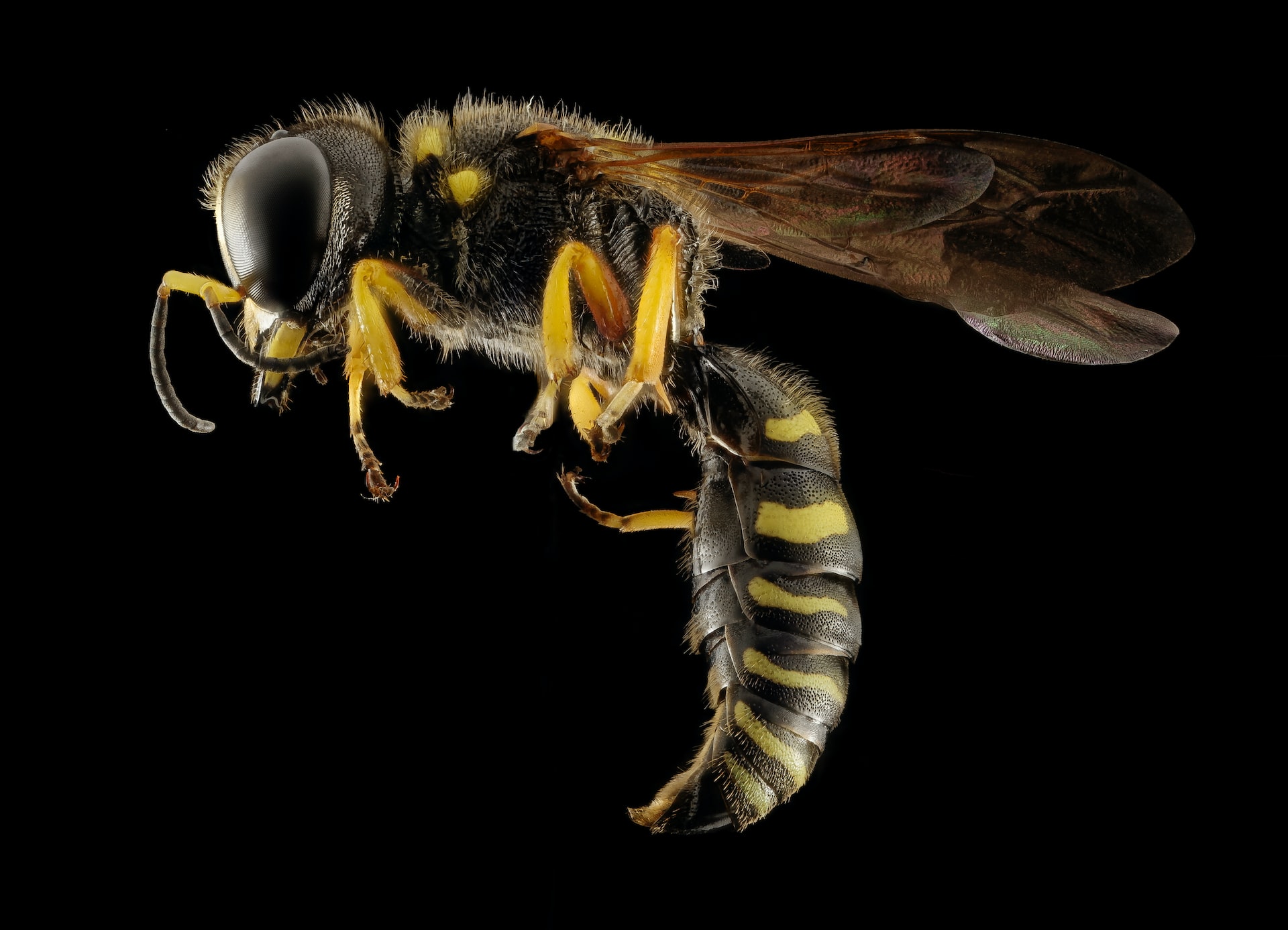As their name implies, stinging insects are insects that use stingers to defend themselves when they feel threatened.
Many are beneficial to crops, facilitating pollination, which is essential for harvests, even including wasps.
However, many stinging insects can be invasive, aggressive, and dangerous.
Identifying which type of stinging insect you are dealing with will help you create a safe and ethical treatment plan to eliminate them.

Types of Stinging Insects
Several species of stinging insects are found in the Baltimore Metropolitan area of Maryland, with the most common being:
Yellow Jackets
Yellow jackets are a predatory species of stinging insects that feed on various other insects. Yellow jackets have segmented, hairless bodies and distinct, thin waists.
When at rest, their wings fold laterally against their bodies. Yellow jacket faces and heads are a blend of black and yellow colors. Their bodies have a well-defined yellow and black striped pattern.
European Hornets
European hornets are long and full-bodied. They are brown with yellow stripes on their abdomen. Their faces are pale in color. European hornets are the only true species of hornet found living in the United States.
Bald-Faced Hornets
Bald-faced hornets have long, thin, wasp-like bodies. Bald-faced hornets are black except for an off-white color pattern on their faces, at the end of their abdomen, and thorax.
Paper Wasps
Paper wasps have pinched waists and long, thin legs that dangle below their bodies when flying. Their bodies are black or brown and have yellow or orange markings. Their wings are grayish.
Mud Daubers
Mud daubers are a large, solitary species of stinging insect. They range in color from black to metallic blue, depending on the exact species, and they may or may not have yellow or green markings.
Cicada Killers
Cicada killers are a large species of wasp. Adults grow between two and three inches in length. Cicada killers range in color from black to rusty red, with yellow and black banding on their abdomen. Their heads are reddish-brown, and they have yellowish-tinted wings that are heavily veined.
Carpenter Bees
Carpenter bees are common wood-damaging insects that are large. Due to their size, these black and yellow bees are often mistaken as bumble bees. However, carpenter bees have smooth, shiny, black abdomens, unlike bumble bees, whose abdomens are yellow and hairy.
Read more: Common Types of Bees and Wasps in Maryland.
Stinging Insect Nests
Nests are another big clue as to what stinging insect you are dealing with. Here is a list of different nests and their appearances.
- Paper Wasps:
-
- Appearance: Paper wasp nests are open, umbrella-shaped, and made of papery material.
- Cells: Nests have visible hexagonal cells where eggs are laid.
- Location: Typically found under eaves, on branches, or in protected areas.
- Hornets:
-
- Appearance: Hornet nests are large, enclosed, and made of paper-like material.
- Entry Point: Nests have a single entry point at the bottom.
- Hanging: They often hang from tree branches, shrubs, or building overhangs.
- Yellow Jackets:
-
- Appearance: Yellow jacket nests can be both enclosed and underground.
- Ground Nests: Underground nests have a small entrance hole.
- Aerial Nests: Enclosed nests are often located in voids, attics, or wall cavities.
- Bumblebees:
-
- Appearance: Bumblebee nests are typically smaller and are found underground or in protected cavities.
- Insulation: Nests might have insulating materials like grass and moss around the entrance.
- Solitary Bees:
-
- Appearance: Solitary bees create individual nests in cavities like holes in wood or hollow plant stems.
- Entrance: Each nest has a single entrance hole.
- Ground-Nesting Wasps:
-
- Appearance: These wasps create small, individual nests in the ground.
- Entrance: Nests have a single entrance hole.
- Mud Daubers:
-
- Appearance: Mud dauber nests are made of mud and have a tube-like structure.
- Cells: Nests contain individual cells where eggs are laid.
- Location: Nests are often found on walls, ceilings, or in sheltered areas.
- Carpenter Bees:
-
- Appearance: Carpenter bees bore into wood to create individual nests.
- Entry Hole: Nests have a perfectly round entry hole.
Are Stinging Insects Dangerous?
While not all species of stinging insects are aggressive, they all can deliver painful, venom-filled stings as a means of defense.
Their venom is usually powerful enough to trigger serious allergic reactions and anaphylaxis in some people, which requires immediate medical attention.
Most bees have barbed stingers, only allowing them to sting once. These bees tend to be fairly docile and only attack when they feel threatened. Other species, like wasps, have smooth stingers, allowing them to sting repeatedly.
These species are typically aggressive, with yellow jackets being considered the most aggressive.
Why Do I Have a Stinging Insect Problem?
Stinging insects, depending on their exact species, feed on various materials, including insects, proteins, nectar, sweets, and honeydew. Many stinging insects are simply attracted to plants in your garden that release pollen.
Stinging insects are most active during the end of the summer and early fall. When their colonies are at peak numbers, they spend much time foraging for food to feed their members.
Compost piles, garbage cans, gardens, flowering vegetation, untreated wooden structures, clogged gutters, outdoor eating areas, bird baths, and ponds are all attractive to stinging insects, making for a warm and welcoming environment.
Where Will I Find Stinging Insects?
There are many places in Maryland for stinging insects to build nests. Where they choose to build their nest depends on their species:
- Yellow jackets are typically ground-nesters, though some will build above-ground nests on houses, buildings, or in bushes and trees with low-hanging limbs.
- European hornets build their large paper nests in natural cavities, including their favorite spots inside hollow trees.
- Bald-faced hornets create paper-like nests three feet or higher up off the ground.
- Paper wasps are semi-social and live together in small colonies. They are often identified by the umbrella-shaped nests that they create from a paper-like material.
- Mud daubers are a solitary species of stinging insect. They create their nests out of mud and other natural materials.
- Carpenter bees are solitary. Females create their individual nests by drilling a hole the diameter of their bodies and tunneling inside older or untreated pieces of wood. They are commonly found nesting in wooden decks, fence rails, wooden trim, wooden furniture, overhangs, and window sills.
- Cicada killers are solitary and do not live in nests. Females create underground burrows. They dig about twelve inches into the ground, creating individual cells to lay their eggs in. Cicada killers prefer to make their nests in lawns and in sandy areas.
Other common nesting spots for stinging insects include underneath porches, decks, and roof eaves. Inside, stinging insects create nests in attics, crawl spaces, chimneys, vents, and outbuildings such as barns, sheds, and garages.
How Can I Prevent Stinging Insects in the Future?
Preventing problems with stinging insects can be difficult. Here are several things you can do in and around your home to deter them:
- Perform regular inspections to identify nests in their infancy.
- Place lids on all outdoor trash cans.
- Keep outdoor eating areas cleaned up.
- Remove water sources from around your property.
- Fill in ground holes, remove fallen trees, and remove tree stumps.
- Remove wood piles, rock piles, and other debris.
- Trim tree limbs and flowering vegetation away from the exterior of your home.
- Seal cracks and crevices in the foundation and exterior walls of your home.
- Place a cap on your chimney.
- Repair holes along the roofline and at roof intersections.
- Keep outbuilding doors shut when not in use.
How Do I Get Rid of Stinging Insects?
To eliminate potentially dangerous stinging insects from your home or property and prevent a re-infestation, partner with a knowledgeable professional.
Due to the aggressiveness of most stinging insects, getting rid of a wasp nest without being stung is very difficult.
At Pest Czar, our local and experienced professionals can provide the comprehensive services needed to find and safely eliminate the stinging insects living in your home, outbuildings, or on your property.
We can prevent their return by implementing one of our GreenPro-certified pest protection plans. For exceptional, eco-friendly stinging insect control services in the Baltimore Metro area of Maryland, call us at Pest Czar!
FAQs: Stinging Insect Guide
What should I do if I find a stinging insect nest near my home?
Safety is paramount. Keep a safe distance from the nest and avoid sudden movements.
If the nest is in a high-traffic area, consider consulting a professional pest control service. Attempting nest removal yourself can be risky, especially if you’re allergic to stings.
How can I prevent stinging insects from nesting on my property?
Trim vegetation near your home to reduce nesting sites. Seal openings in walls, attics, and eaves to prevent nest establishment.
Avoid leaving food or sweets exposed, as they can attract stinging insects.
What should I do if I’m stung by a stinging insect?
Remove the stinger gently using a credit card or your fingernail to prevent further venom injection. Wash the area with soap and water and apply a cold compress to reduce swelling.
Over-the-counter antihistamines and pain relievers can help alleviate symptoms. If you experience severe reactions like difficulty breathing or facial swelling, seek medical attention immediately.
Can stinging insects benefit the environment?
Absolutely. Stinging insects, particularly bees, are crucial pollinators that facilitate the reproduction of flowering plants.
They contribute to the diversity and health of ecosystems by supporting plant growth and the food chain.
How can I safely remove a stinging insect nest?
DIY nest removal can be risky. It’s safer to call a professional pest control service.
If you choose to proceed, do so at night when stinging insects are less active. Wear protective clothing, approach the nest slowly, and use an approved insecticide labeled for nest removal.
What are some natural ways to repel stinging insects?
Citronella, eucalyptus, and mint oils can help deter stinging insects. Planting marigolds, lavender, and basil around outdoor spaces can also discourage them.
However, natural methods may not provide complete protection and may be less effective than professional treatments.
Get Started Today with a Free Quote
Complete the form below to schedule your no obligation inspection.
- Zero-Contact Service
- Same-Day Inspection/Service
- Real-Time Notifications

Customer Reviews
“Joe is knowledgeable and professional. Thanks for the great service!”
Adam | Reisterstown, MD | Read Reviews


